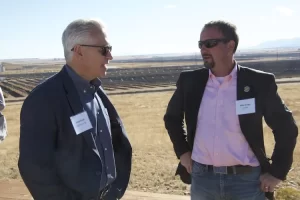Widgetized Section
Go to Admin » Appearance » Widgets » and move Gabfire Widget: Social into that MastheadOverlay zone
Colorado Solar and Storage trade group booming as industry takes off, adds thousands of workers

Colorado Solar and Storage Association has expanded its membership from 83 business members to 275 during the last several years.
Is COSSA giving out ski passes to new members?
No such thing, says Mike Kruger, the executive director since 2018. He points to both broad economic and industry trends but also strategic moves by the organization.
Employment numbers illustrate the industry’s growth in Colorado. Last year 9,000 people were directly engaged in solar installation or the development process. This compares with 6,000 just a few years ago.
“Solar energy in the United States is booming,” proclaimed the Solar Energy Industry Association, a national trade group, in a report from late 2022.
The market size of the U.S. solar power industry has grown 20.7% per year on average from 2018 to 2023, reports IBIS World, an industry research firm. It projects the same pace of growth in 2023. Citing the national solar trade group, the New York Times recently reported an even larger figure: an average 33% per year. By the third quarter of 2022, 45% of new generating capacity came from solar.
Residential, commercial, and community solar have expanded, but particularly utility-scale solar projects such as those near Pueblo, including the 300-megawatt Bighorn solar project associated with the steel mill there. It was completed in 2021.
This growth can at least partly be attributed to prices of PV panels that, despite supply-chain disruptions manifested in 2022, have fallen by half since 2010. Technology innovations have also helped make solar more competitive. For example, solar cells can now convert 31.6% of solar energy to electric currents, up from 24.4%.
Then there are public policies, such as those in Colorado, that seek to foster renewables in myriad ways, plus the improved ability of electrical suppliers to integrate high levels of renewables while maintaining high levels of reliability for electrical deliveries.
COSSA’s growth has been the result of strategic moves, both by the 16 board members and some undertaken by Kruger. One of them was the renaming of the organization to pair solar with storage.

“When we did it in 2019, it was pretty danged aspirational,” Kruger says of the inclusion of the name storage. “Everybody knew it had to be the answer.”
Then, storage was still a minor player in the energy picture. Now it has become a major part of the electric resource plans by Xcel Energy but also other electric utilities.
“Three years ago it was aspirational,” says Kruger. “Now it is reality.”
“A lot of our growth has been outside of the Denver metro area,” he says, citing businesses from Grand Junction, Steamboat Springs, Durango, and Alamosa.
This also reflects the directions given by Kruger to develop relations across Colorado with electrical cooperatives, municipal utilities, and others. The broad goal is to lower tensions to a level that conversations can occur.
“We won’t agree with each other all the time, but at least they know they have a partner that they can go to and ask questions.”
This, in turn, helps the members of the association, as the trade group can engage with local officials. “The bulk of installations are still in the Denver area, but we are starting to see very large installations in Pueblo and Weld County attracting national companies.”
This, says Kruger, contrasts with COSSA in its earlier iteration, when the organization more narrowly focused on Xcel Energy and its operations in the Denver-Boulder area. COSSA is still in those discussions, but there’s a larger picture.
Kruger credits staff members that include Cathy Boies, who arrived as policy director in 2021 after spending time at the Colorado Public Utilities Commission as a policy analyst, and Jason Henderson, who is the vice president of development and has been in the solar industry for a decade.
As for Kruger, he came to Colorado knowing very little about the state. A one-time middle-school teacher, he learned about public policy development while working for the Obama Administration and about the electric power sector as the Director of Communications for the Smart Electric Power Alliance. As for Colorado, it was a mystery.
“Man, I am embarrassed to say that I came to Colorado for the lifestyle that I saw on TV and social media. And I had only visited a few times,” he says. “I couldn’t have found Kit Carson County with a map.”
Reflective of that broadened, deepened understanding is Kruger’s travel schedule. He travels to Lamar and Durango, Alamosa and Craig in the course of his work.
He also knows that Kit Carson, the county, is located along the Kansas border, its largest town, Burlington, spliced by Interstate 70. Likely he knows there’s another Kit Carson —the town, this one bisected by an extension of East Colfax Avenue, otherwise known as Highway 40. And he’s seen Kit Carson Peak, the 14er in the Sangre de Cristo Range.
Editor’s note: Allen Best is a Colorado-based journalist who publishes an e-magazine called Big Pivots, where this post first appeared. Reach him at allen.best@comcast.net or 720.415.9308.
Latest posts by Allen Best, Big Pivots (see all)
- Trump’s Big Beautiful Bill could have an ugly impact on your Colorado electric bill - June 5, 2025
- Analysis: Colorado data center bill raises serious questions of electric consumers subsidizing Big Tech - April 15, 2025
- Hurd, Evans walking fine line on renewable energy as Trump pushes ‘drill, baby, drill’ oil, gas agenda - March 21, 2025


